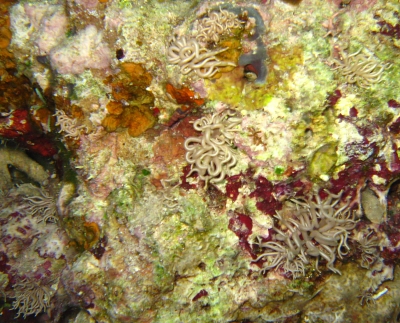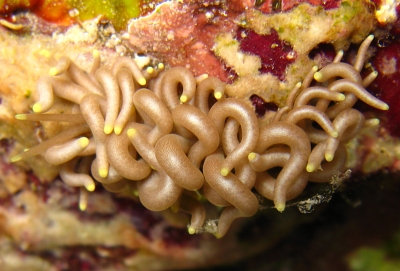Phyllodesmium briareum from the Philippines
August 14, 2008
From: Marcel Tanke

Dear Bill,
In Cebu-Moalboal we found in 2 separate locations, a rather large aggregation of Phyllodesmium briareum. In both cases they were on top of a thin layer of sponge (?) that covered the reef. There were maybe several hundreds of them. The first picture attached alone shows some 20 P. briareum already.
We watched- and took pictures for several minutes. We did not see one that moved, not even a little bit. I tried to make them move by waving my hand and move some water over them. They were stuck very strongly to the sponge (?), no movement at all. We also saw that several had their cerata 'bent' towards their mantle. I read somewhere on your forum (can't find it anymore) that you referred to it as 'sleeping'. Any other / additional information why they are doing this?
Locality: Cebu Island, Moalboal, 10-15 meter, Philippines, 28 April 2008. Length: 4mm - 3 cm. Photographer: Marcel Tanke.
Thanks and regards,
Marcel
marceltanke@cs.com



Dear Marcel,
I did a quick search on the Forum and couldn't find my reference to 'sleeping' but it worth remembering that this is a solar-powered sea slug, so it needs to ensure that the plant cells in its body get plenty of sunlight so they can photosynthesise and provide it with food. I have included a close-up to show the lines of brown specks in the cerata, which are the clusters of microscopic plants [zooxanthellae] living in ducts of the digestive gland. This species gets it zooxanthellae by eating a soft coral which often has a dark purple colour form. I can't see any sign of its food in your photo so its possible the Phyllodesmium have completely eaten out the soft coral colony and are now acting as plants by 'sunning' themselves in an unshaded place. If you look through some of the earlier messages on the Forum about this species, you will find they are often found in large aggregations. I wouldn't be surprised if this indicates that they have either direct development or an abbreviated development, which would mean all the hatchlings from one egg ribbon grow up together in the same area, presumably on one soft coral colony.
Interestingly the other major group of solar-powered slugs - the sacoglossans which keep chloroplasts alive in their tissues - have members which also laze about in the sunlight, much for the same reason.
Best wishes,
Bill Rudman
Related messages
-
Phyllodesmium briareum? from Vietnam
From: Hua Thai Tuyen, March 6, 2008 -
Phyllodesmium briareum from Lembeh
From: Bruce Wight, February 17, 2007 -
Phyllodesmium briareum from Sulawesi
From: Mike Krampf, November 30, 2006 -
Re: Phyllodesmium briareum from Singapore
From: Toh Chay Hoon, November 27, 2006 -
Phyllodesmium briareum from Singapore
From: Toh Chay Hoon, May 27, 2006 -
Re: Phyllodesmium briareum in aquarium shipment
From: Michael Mrutzek, March 1, 2006 -
Phyllodesmium briareum in aquarium shipment
From: Michael Mrutzek, February 27, 2006 -
Phyllodesmium briareum from Malaysia
From: Ho Wei Kwok Alvin, October 8, 2005 -
Phyllodesmium briareum from Vanuatu
From: Vinka Stenhouse, March 10, 2003 -
Phyllodesmium briareum from Malaysia
From: Richard Houghton, July 14, 2002 -
Phyllodesmium briareum from Papua New Guinea
From: John Chuk, July 8, 2002 -
Phyllodesmium briareum from west Malaysia
From: Kheong Sann Chan, July 2, 2002 -
Phyllodesmium briareum from Malaysia
From: Kenneth Leong, June 30, 2002 -
Phyllodesmium from Pulau Aur, Malaysia
From: Barbara Phua, June 26, 2002 -
Re: Phyllodesmium briareum eggs
From: Mary Jane Adams , May 27, 2001 -
Phyllodesmium briareum egg laying
From: Mary Jane Adams , May 26, 2001 -
Re: Phyllodesmium briareum from SE Sulawesi
From: Lindsay Warren, February 21, 2000 -
Phyllodesmium briareum - direct development?
From: Lindsay Warren, February 18, 2000 -
Phyllodesmium briareum from Japan
From: Rie Nakano, November 29, 1999
